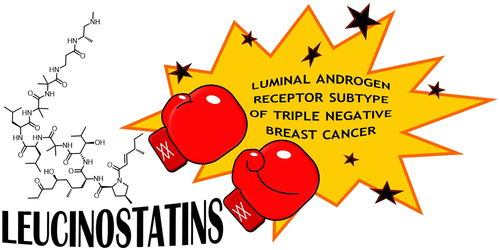当前位置:
X-MOL 学术
›
J. Nat. Prod.
›
论文详情
Our official English website, www.x-mol.net, welcomes your feedback! (Note: you will need to create a separate account there.)
Leucinostatins from Ophiocordyceps spp. and Purpureocillium spp. Demonstrate Selective Antiproliferative Effects in Cells Representing the Luminal Androgen Receptor Subtype of Triple Negative Breast Cancer.
Journal of Natural Products ( IF 5.1 ) Pub Date : 2020-06-08 , DOI: 10.1021/acs.jnatprod.0c00404 Yun-Seo Kil 1 , April L Risinger , Cora L Petersen , Susan L Mooberry , Robert H Cichewicz 1
Journal of Natural Products ( IF 5.1 ) Pub Date : 2020-06-08 , DOI: 10.1021/acs.jnatprod.0c00404 Yun-Seo Kil 1 , April L Risinger , Cora L Petersen , Susan L Mooberry , Robert H Cichewicz 1
Affiliation

|
The structures of four leucinostatin analogues (1–4) from Ophiocordyceps spp. and Purpureocillium spp. were determined together with six known leucinostatins [leucinostatins B (5), A (6), B2 (7), A2 (8), F (9), and D (10)]. The structures of the metabolites were established using a combination of analytical methods including HRESIMS and MS/MS experiments, 1D and 2D NMR spectroscopy, chiral HPLC, and advanced Marfey’s analysis of the acid hydrolysate, as well as additional empirical and chemical methods. Compounds 1–10 were evaluated for their biological effects on triple negative breast cancer (TNBC) cells. Leucinostatins 1–10 showed selective cytostatic activities in MDA-MB-453 and SUM185PE cells representing the luminal androgen receptor subtype of TNBC. This selective activity motivated further investigation into the mechanism of action of leucinostatin B (5). The results demonstrate that this peptidic fungal metabolite rapidly inhibits mTORC1 signaling in leucinostatin-sensitive TNBC cell lines, but not in leucinostatin-resistant cells. Leucinostatins have been shown to repress mitochondrial respiration through inhibition of the ATP synthase, and we demonstrated that both the mTORC1 signaling and LAR-selective activities of 5 were recapitulated by oligomycin. Thus, inhibition of the ATP synthase with either leucinostatin B or oligomycin is sufficient to selectively impede mTORC1 signaling and inhibit the growth of LAR-subtype cells.
中文翻译:

来自 Ophiocordyceps spp. 的亮氨酸抑制素。和 Purpureocillium spp。在代表三阴性乳腺癌管腔雄激素受体亚型的细胞中展示选择性抗增殖作用。
四个leucinostatin类似物(结构1 - 4从)Ophiocordyceps属。和Purpureocillium spp。与六种已知的亮氨酸抑制素 [亮氨酸抑制素 B ( 5 )、A ( 6 )、B2 ( 7 )、A2 ( 8 )、F ( 9 ) 和 D ( 10 )]一起测定。代谢物的结构是通过结合分析方法确定的,包括 HRESIMS 和 MS/MS 实验、1D 和 2D NMR 光谱、手性 HPLC、酸水解物的高级 Marfey 分析,以及其他经验和化学方法。化合物1 – 10评估了它们对三阴性乳腺癌 (TNBC) 细胞的生物学影响。亮氨酸抑素1 – 10在代表 TNBC 管腔雄激素受体亚型的 MDA-MB-453 和 SUM185PE 细胞中显示出选择性细胞抑制活性。这种选择性活性激发了对亮氨酸抑素 B ( 5 )作用机制的进一步研究。结果表明,这种肽真菌代谢物在亮氨酸抑制素敏感的 TNBC 细胞系中快速抑制 mTORC1 信号传导,但在亮氨酸抑制素抗性细胞中没有。Leucinostatins已经显示通过抑制ATP合酶的压制线粒体呼吸,我们证明了mTORC1信号和LAR选择性活动既5由寡霉素概括。因此,用亮氨酸抑素 B 或寡霉素抑制 ATP 合酶足以选择性地阻止 mTORC1 信号传导并抑制 LAR 亚型细胞的生长。
更新日期:2020-06-26
中文翻译:

来自 Ophiocordyceps spp. 的亮氨酸抑制素。和 Purpureocillium spp。在代表三阴性乳腺癌管腔雄激素受体亚型的细胞中展示选择性抗增殖作用。
四个leucinostatin类似物(结构1 - 4从)Ophiocordyceps属。和Purpureocillium spp。与六种已知的亮氨酸抑制素 [亮氨酸抑制素 B ( 5 )、A ( 6 )、B2 ( 7 )、A2 ( 8 )、F ( 9 ) 和 D ( 10 )]一起测定。代谢物的结构是通过结合分析方法确定的,包括 HRESIMS 和 MS/MS 实验、1D 和 2D NMR 光谱、手性 HPLC、酸水解物的高级 Marfey 分析,以及其他经验和化学方法。化合物1 – 10评估了它们对三阴性乳腺癌 (TNBC) 细胞的生物学影响。亮氨酸抑素1 – 10在代表 TNBC 管腔雄激素受体亚型的 MDA-MB-453 和 SUM185PE 细胞中显示出选择性细胞抑制活性。这种选择性活性激发了对亮氨酸抑素 B ( 5 )作用机制的进一步研究。结果表明,这种肽真菌代谢物在亮氨酸抑制素敏感的 TNBC 细胞系中快速抑制 mTORC1 信号传导,但在亮氨酸抑制素抗性细胞中没有。Leucinostatins已经显示通过抑制ATP合酶的压制线粒体呼吸,我们证明了mTORC1信号和LAR选择性活动既5由寡霉素概括。因此,用亮氨酸抑素 B 或寡霉素抑制 ATP 合酶足以选择性地阻止 mTORC1 信号传导并抑制 LAR 亚型细胞的生长。


























 京公网安备 11010802027423号
京公网安备 11010802027423号